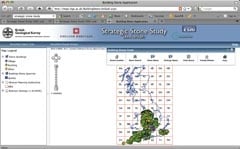English Heritage have managed to juggle their finances to continue to fund the Strategic Stone Study until the end of this financial year (the end of March 2012).
The Strategic Stone Study is the most important project ever undertaken to identify and record the sources and uses of building stones in England. The British Geological Survey (BGS) is collating the information and putting it on to a Geological Information System (GIS) on a freely accessible website (pictured right).
Initially, just over £500,000 was allocated for the study, the Department of Communities & Local Government paying £280,000 and English Heritage the rest. At the end of this year progress was due to be reviewed with the intention of allocating another sum of up to £500,000 to finish the project.
But with the project about 60% finished (in terms of regions covered) the Department of Communities & Local Government has withdrawn its support.
That is in spite of the English Heritage National Heritage Protection Plan (NHPP) having identified the protection of traditional building material sources as a priority for protecting the national heritage, with stone and thatching specifically mentioned.
The NHPP sets out how English Heritage, with help from partners in the sector, will prioritise and deliver heritage protection between 2011 and 2015. Its stated aim is to ensure best use is made of resources so that the historic environment is safeguarded in the most cost-effective way.
Chris Wood, Head of the English Heritage Building Conservation & Research Team, told NSS he is still working with BGS to try to secure funding for the Strategic Stone Study beyond the end of this financial year.
However, he believes that even if further finance cannot be secured, when all the information gathered by the end of the year is entered on to the GIS maps, the main areas of England where stone is used for building will have been covered.
For the purposes of the study the country was divided into 47 areas to make the study manageable. There will probably be information on 26-28 of them by April, although there is a long way to go before all the stone buildings are included, as they were originally intended to be. That still might be achieved if BGS maintain the database in the longer term so that details can continue to be added.
Tarnia McAlester continues to head the project for English Heritage but is no longer employed on it full time, having returned to her studies.

